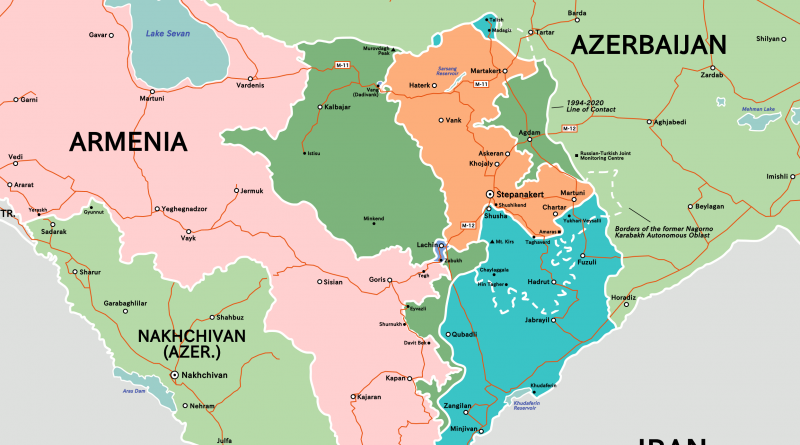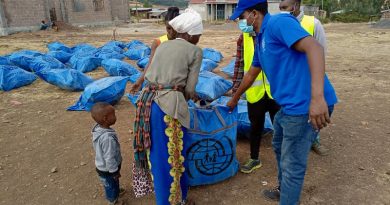FOCUS on Separatist States: Nagorno-Karabakh
Mia DiPaola
Staff Writer
Violence erupted in late 2020 between Armenia and Azerbaijan in Nagorno-Karabakh, a disputed territory self-declared as the Republic of Artsakh by its majority Armenian population. Amidst the COVID-19 pandemic, the region became a tinderbox waiting to erupt into conflict following the 1994 ceasefire.
Centuries of tensions once again sparked the conflict, as a six-week war broke out between Armenia and Azerbaijan in late September 2020. The majority of the region is ethnically Armenian but recognized by the international community as part of Azerbaijan,. According to the New York Times, thousands were killed as Azerbaijan reclaimed large swaths of territory lost decades earlier to Armenia. Backed by Turkey, Azerbaijan used sophisticated drone attacks in addition to the powerful, long-range rocket artillery used by both sides.
Fighting has been rife since 1988, reports BBC News. Tension between the Christian Armenians and the Turkic Azeris has been a centuries-long norm, but the two groups coexisted in relative peace until the 20th century. The then-newly-formed Soviet Bolshevik government created the Nagorno-Karabakh Autonomous Region with an ethnic Armenian majority inside the Soviet Socialist Republic of Azerbaijan. As the Soviet Union’s power declined, war broke out among Armenian secessionists and the Azerbaijani military when the region’s population voted to join Armenia. In 1991, Karabakh declared itself an independent republic, though not even its closest ally and main financial and military backer, Armenia, has officially recognized its independence.
The war ended in 1994 with a Russia-brokered cease-fire. At that point, Armenia controlled Nagorno-Karabakh and 20 percent of the surrounding Azerbaijani territory, according to the Council of Foreign Relations. The cease-fire effectively halted conflict for over a decade, but the simmering tension again boiled over in April of 2016. After four days of intense fighting that left more than 300 dead, a new cease-fire was called, but talks broke down and left repeated cease-fire violations and high tension in its wake.
The brief but bloody war last year has put Armenian Prime Minister Nikol Pashinyan in hot water. The Wall Street Journal reports that “turmoil has engulfed Armenia.” Dissatisfied with the truce agreement, Armenians have taken to the streets in protest and called for the resignation of Mr. Pashinyan. The prime minister has so far refused to resign but called for a snap election which will take place in June. As the main backer of Armenians in Karabakh, this election will likely have a lasting impact on the region.
The looming election only adds to the political uncertainty of the region, as the most recent war in Karabakh disrupted the breakaway state’s politics, according to Radio Free Europe Radio Liberty. Initially following the ceasefire, many of the ethnic Armenians in Karabakh demanded the resignation of de facto President Arayik Harutiunian. However, he currently is still in power despite replacing nearly his entire cabinet since November 10 and promising to resign. The other contender for political power is Karabakh’s influential security chief, Vitaly Balasanian. The two competed against each other in the 2020 presidential election, in which Mr. Harutiunian narrowly won and Mr. Balasanian secured 15 percent of the vote and finished third. While the future of the presidency is uncertain, one thing is not: Russia’s strong presence in the region.
What was once a local dispute has grown into a regional issue as Turkey and Russia become further embroiled in the conflict and exert their influence – The Nagorno-Karabakh conflict is just the latest in a series of proxy wars between the two states. After competitions in Syria and Libya where Russia and Turkey-backed opposing factions, Nagorno-Karabakh is the next battleground. Turkey, through its recent backing of Azerbaijan, played a much larger role in the conflict than before and proved itself a valuable ally. Russia plays a more visible role in the conflict, both in its longtime backing of Armenia and in its new role as a peacekeeping force in Karabakh. An unnamed official said Harutiunian has remained in power in Karabakh through Russian backing. Radio Free Europe reports the official as saying, “I don’t think [Harutiunian] is going anywhere… he said he wouldn’t leave because the Russians want him there.”
While the situation seems bleak, Brookings reports that there could be some hope for lasting peace. Lasting peace between Azerbaijan and Armenia, particularly over Nagorno-Karabakh, may seem impossible due to the centuries of tension, but experts believe that Turkey could serve as an “honest broker”. Turkey previously endeavored to repair its relationship with Armenia, including offering condolences to the families of Armenians killed during World War I. There is still work to be done, however, as Armenia desires recognition and acknowledgment of the Armenian Genocide.
Photo courtesy of Kalj (Wikimedia Commons)



